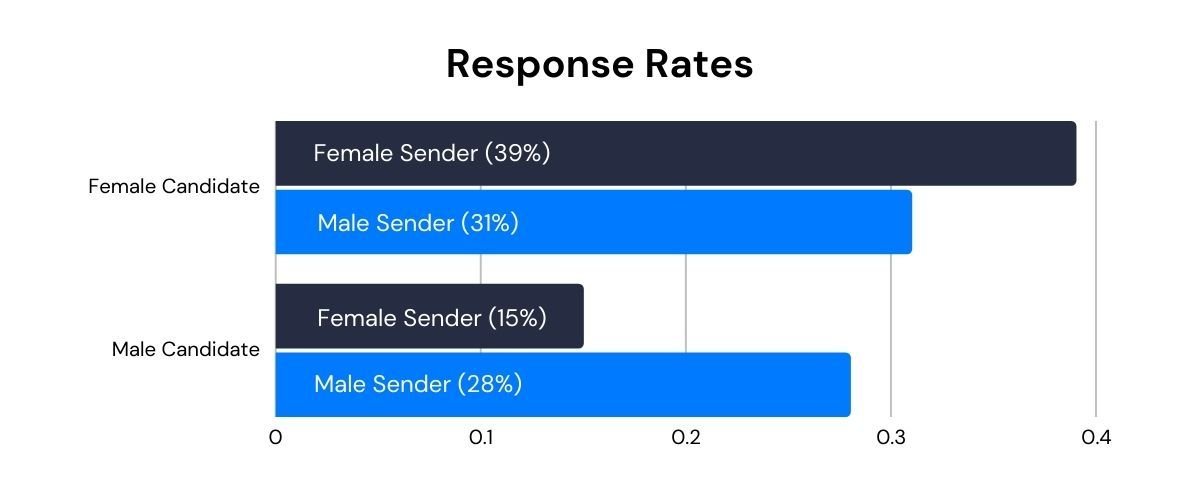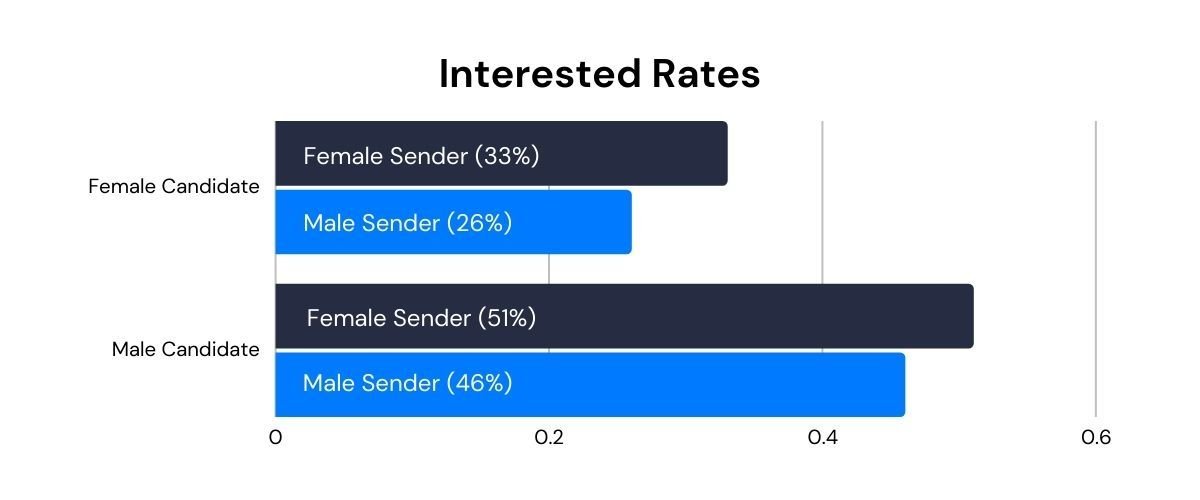As a recruiter, you’ve put plenty of time and effort into developing outreach messages that excite and engage candidates.
Ideally, you’ve created an outreach strategy that’s eye-catching and inclusive in order to appeal to the broadest range of candidates. The first touchpoint your company has with a potential candidate impacts the overall makeup of your talent pool, especially as workplaces make adjustments to counteract the She-Cession and increase diversity at all levels.
As you know, detailed subject lines and personalization go a long way in sparking interest. But have you considered who is behind your recruiting emails, and what impact the sender has on candidates’ interest? Recent data pulled from Fetcher reveals that who your emails are coming from has a major effect on how candidates respond to outreach.
Breaking down the data behind response & interested rates
For this analysis, we included all emails sent from the Fetcher platform between January 2019 and February 2022, which totals over two million emails. Our team looked at two stats: the response rate (what percentage of candidates responded to an email they received), and the interested rate (what percent of candidates indicated they were interested in a role, based on their email response). Each of these stats were then broken down by the gender of the email sender, and the gender of the candidate receiving the email.
With Fetcher, clients can have emails come from anyone in their organization. This means the sender could be a recruiter or HR team member, but in many cases, the sender is the hiring manager. Receivers of these recruiting emails are all passive candidates, which means these are people who meet the criteria for an open role but who haven’t actively applied to the role.
The main takeaways of the data?
✔️ Male candidates are nearly twice as likely to respond to a male sender than a female sender.
✔️ Female candidates also show a slight bias towards their own gender, with a response rate .08 higher with female senders than male.

✔️ Women are more likely to respond overall, even if they aren’t interested in the opportunity.
✔️ Men are more likely to respond only if they are interested in the role.

What these stats mean for your hiring strategy
There’s no easy way to say it: Male candidates are still showing negative bias in responding to, or even working for, female hiring managers. Despite the progress towards gender equity and equality in the workforce, perceptions about female managers and executives may cause lower response rates among male candidates. For hard-to-fill, male-dominated roles like tech and sales, this causes an unfortunate cycle in which men are only interested in roles with male leadership.
However, there is a silver lining that could empower more outreach from women. Because women respond more often to women vs. men, companies that involve women in outreach are more likely to engage female candidates. Again, in male-dominated spaces, relying on female senders is one way to increase interest from women, and increase gender diversity in your pipeline.
The makeup of your talent pipeline doesn't have to be a mystery. Learn more about Fetcher's diversity stats and how our clients are using them to drive their diversity hiring strategies.
How do we break the bias?
In the era of The Great Reshuffling and high concerns over DE&I, companies need to consider who is behind their recruiting emails. However, there’s a bigger question on the table: how do companies shift male perceptions about women at work and in leadership roles, and decrease gender bias?
As a talent acquisition professional, it may seem out of the scope of your role to influence a candidate’s thoughts and opinions related to gender. This is a longer game: the more companies make DE&I a priority, the more the entire workforce (including potential candidates) can shift away from biased attitudes and work cultures. What can you do now to start the process?
🙋♀️ If you’re in a leadership role or part of the hiring process, have conversations on the prevalence of gender bias. Share with your teams that only 8.2% of CEOs are women. Let them know that women (and specifically women of color) face challenges in job-seeking due to outdated attitudes and lack of flexibility, which is also a big reason why more than one million women have yet to return to the workforce after the pandemic.
🙋♀️ Pair discussions of the realities of women at work with the potential business impact of closing wage and equality gaps: $12 trillion dollars added to the global GDP by 2025. On a smaller scale, companies that prioritize gender equality in their hiring practices and workforce also earn 41% higher revenue than those that don’t.
🙋♀️ Implement DE&I training programs that review the different types of bias and how they could impact hiring decisions. If everyone at your company, including hiring managers and executives, understands how bias plays out in real-life scenarios, they’ll be more likely to recognize it and course-correct in the future.
🙋♀️ Ask for candidate feedback from all candidates, whenever possible. Numbers reveal a bigger picture or trend, but they can’t provide insights into an individual’s experience. Obviously you won’t ask specifically if gender played a role in their decision-making, but you can ask more generally about the pros and cons of their candidate experience. Empowering all candidates to be open with you may shed light on areas of your hiring that cause tension or disinterest.
Recruiting tools can help you better understand the diversity of your candidate pipeline, so you can take meaningful steps to hire more underrepresented talent. Reach out to us to schedule your free demo and get started today.
About Fetcher
Our mission is to help you engage talent that will transform your business aspirations into reality. Great talent is hard to find - that's why we offer a talent sourcing platform that not only gets your brand in front of the right candidates but also gives you a competitive edge in talent acquisition.
Begin building a relationship with your next great hire today and let Fetcher handle the rest. Learn more.




